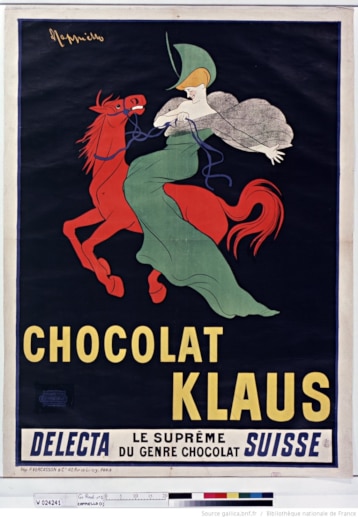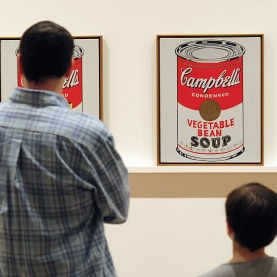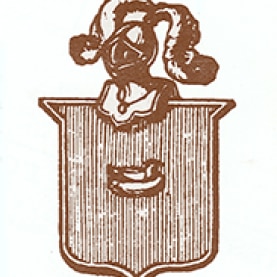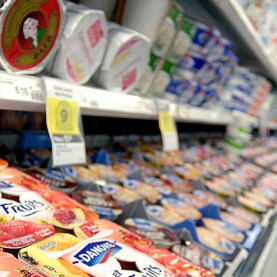Packaging – advertising
Advertising took off with the industrialisation of cities from 1850. As advertising was initially text-based, it was confined to the print press and thereby aimed at a literate audience. Advertising cosmetic products paved the way for advertising the budding food industry. Posters became omnipresent and growing competition required food producers to reinvent themselves and advertise through samples, promotional items and display packages for shop windows. Advertising ensures that brand names are truly born.
The advertising boom, from advertisement to poster
Advertising, in the modern sense of bringing something to the public’s attention, came into being at the same time as the press, i.e. in 17th century Europe. Advertisements became more common but still took a very basic form, comprised mainly of text with the use of an asterisk, hand or Nota Bene to attract the public’s attention. Essential daily products were seldom advertised as people knew where to find them. In the 18th century, in England, advertisements spread like wildfire all over newspapers, which later banned them when their numbers became overwhelming. In France, however, advertisements did not appear in the press until 1830 as, just after 1789, the economy was still shaky and manufacturing remained local. The Industrial Revolution radically changed the face of advertising: The advent of chromolithography and with public transport providing useful advertising media, the poster made its appearance, billboards abounded, discarded leaflets littered the streets, banners flew in the sky and sandwich board men, who were cluttering up the streets, were relegated to the gutter in Victorian London. In Paris, the urban development work of Georges-Eugène Haussmann meant that construction site screens on the boulevards provided ideal spots for mass billposting. From 1880, the poster style was established as a formal basis for other types of advertising and product labels. The illustrated magazine and the illuminated sign made their first appearance. Advertising agencies enjoyed a boom, as they no longer just rented or sold advertising space, but now offered services. Some companies, like Maggi for example, created their own advertising and communication departments. Competition became tougher and registered trademarks came into being. Commissions were placed with well-known artists, for example, at the turn of the century, Alfons Mucha created artwork for brands such as Nestlé in the Art Nouveau style, while Leonetto Cappiello, today considered as a pioneer poster artist, brought the poster into the contemporary era ahead of its time by breaking the rules of the Belle Époque. He simplified shapes and the colour palette, an approach which proved particularly successful for Chocolat Klaus in 1903. Shop windows were filled with display packages and the promotional item entered consumers’ private sphere.
Conquering the private sphere
Besides advertising in the printed press and on the radio from 1922 onwards, advertising entered the domestic sphere through food packaging which, by that point, was displaying the attributes of both the brand and product. The tin box with its removable lid took pride of place. Once its contents had been consumed, it was often reused: “The biscuit tin, whose format matched a kilo of sugar, was the biggest success in this area. The brand was omnipresent in the kitchen, leading women to naturally buy the same product again when it was time to restock.” (Touiller Feyrabend, 1994). Alongside such multi-purpose packaging, various promotional items were used to build consumer loyalty. In exchange for collecting tokens from the packaging, they would receive gifts such as pencils, fountain pens, diaries or knives that acted as brand ambassadors accompanying them in their daily life.
http://cappiello.fr, consulté le 03.11.2015.
SEIFERT, Annatina (éd.), 2008. De la cuisine à l’usine. Les débuts de l’industrie alimentaire en Suisse. Catalogue d’exposition. Vevey : Alimentarium.
TOUILLER FEYRABEND, Henriette, 1994. La saga des objets publicitaires ou la stratégie du cheval de Troie. In : Mise en boîte, Paris : Réunion des Musées Nationaux, pp. 157-164.
WILLIAMS, Raymond, VERNET, Marc. Publicité : le système magique. Réseaux, volume 8, n° 42, 1990. La publicité, pp. 73-95. [en ligne], http://www.persee.fr, consulté le 30.10.2015.
MUSEE NATIONAL DES ARTS ET TRADITIONS POPULAIRES, 1994. Mise en boîte, Paris : Réunion des Musées Nationaux.
TSIKOUNAS, Myriam, 2010. La publicité, une histoire, des pratiques. Sociétés et Représentations. Vol. 2, no 30, Publications de la Sorbonne, pp. 195-209. http://www.cairn.info, consulté le 02.11.2015.






